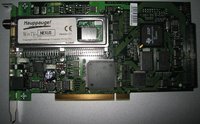FF Rev. 2.1 DVB-S Cards: Difference between revisions
No edit summary |
(fixed name and some formating) |
||
| (14 intermediate revisions by 4 users not shown) | |||
| Line 1: | Line 1: | ||
[[Image:Hauppauge_WinTV_Nexus-s_Rev.2.1.jpg|thumb|right|200px|Hauppauge Nexus-s Rev. 2.1 Card]] |
|||
These cards sold by [[Hauppauge]] have an onboard MPEG decoder and have originally been derived from the old [[Siemens]] cards. Based on an [[SAA7146]] PCI bridge and an [[AV711x]] [[MPEG2 Decoder]] they look quite old-fashioned now but have worked reliably for a long time and been the base for Projects like [[VDR]]. |
|||
A, so called, "[[Full-featured Card|full-featured]]", revision 2.1, [[DVB-S]] [[DVB-S_PCI_Cards|PCI card]]. |
|||
| ⚫ | |||
| ⚫ | |||
==Overview/Features== |
|||
A major drawback of this design is the low maximum [[Bus Bandwidth]] limited by the [[AV711x]], HDTV receiption or raw [[MPEG2 Transport Stream]] access is not possible. |
|||
Originally derived from the old [[Siemens]] DVB-C card design. The Rev. 2.2 is Sold by: |
|||
* [[Hauppauge]] as the WinTV-NEXUS-S. |
|||
The, so called, "[[Full-featured Card|full-featured]]" cards look quite old-fashioned now, but nonetheless, they have worked reliably for a long time and have been the base for Projects like [[VDR]]. However, a major drawback of the "full-featured" card design is the low maximum [[Bus Bandwidth]] limit inherent to the [[TI AV711x|AV711x]], and which effectively means that, because of this, HDTV receiption or raw [[MPEG-2 Transport Stream]] access is not possible. Since even [[MPEG-2 Decoder|MPEG-2 decoders]] implemented in software perform well on [[HDTV]] sources when run on modern PC systems, there is usually no need for cards with onboard MPEG-2 Decoder today. An exception may be special software that relies on proprietary card features like [[VDR]] (although, even in that case, you can also use the [[VDR Software Decoder Plugin]] which effectively allows you to use any card you want with VDR). |
|||
| ⚫ | |||
===Components Used=== |
|||
| ⚫ | |||
* [[Philips SAA7146|SAA7146]] PCI bridge |
|||
* [[TI AV711x|AV711x]] [[MPEG-2 Decoder]]. |
|||
==Making it Work== |
|||
A Firmware is required and available for download on http://www.linuxtv.org/. |
|||
(stv0299/ALPS BSRU6(tsa5059) OR ves1893/ALPS BSRV2(sp5659)) |
|||
features: decoder, partialts |
|||
card driver: dvb-ttpci |
|||
interface: PCI |
|||
PCI device id: 1131:7146 |
|||
PCI subsystem id: 13c2:0003 |
|||
Bridge: Philips SAA7146A |
|||
audio DAC: Texas Instruments TLC320AD80C |
|||
frontend possibility 1: |
|||
tin box: ALPS BSRU6 |
|||
frontend driver: stv0299 |
|||
demodulator location: tin box |
|||
demodulator: ST stv0299b @0x68 |
|||
PLL: Philips tsa5059 @0x61 |
|||
frontend possibility 2: |
|||
tin box: ALPS BSRV2 |
|||
frontend driver: ves1x93 |
|||
demodulator location: tin box |
|||
demodulator: ves1893 @0x08 |
|||
PLL: Mitel sp5659 @0x61 |
|||
Notes: This card has only one frontend - but there are two possibilities |
|||
This card has the same PCI ID as the other rev2.X DVB-S cards |
|||
==Also See== |
|||
* [[DVB-S_PCI_Cards#Rev._2.1_Cards:|Overview of DVB-S Rev. 2.1 Cards]] |
|||
[[Category:DVB-S]] |
|||
[[Category:Hardware]] |
|||
Latest revision as of 20:44, 8 November 2008
A, so called, "full-featured", revision 2.1, DVB-S PCI card.
Linux Support for these cards is quite stable.
Overview/Features
Originally derived from the old Siemens DVB-C card design. The Rev. 2.2 is Sold by:
- Hauppauge as the WinTV-NEXUS-S.
The, so called, "full-featured" cards look quite old-fashioned now, but nonetheless, they have worked reliably for a long time and have been the base for Projects like VDR. However, a major drawback of the "full-featured" card design is the low maximum Bus Bandwidth limit inherent to the AV711x, and which effectively means that, because of this, HDTV receiption or raw MPEG-2 Transport Stream access is not possible. Since even MPEG-2 decoders implemented in software perform well on HDTV sources when run on modern PC systems, there is usually no need for cards with onboard MPEG-2 Decoder today. An exception may be special software that relies on proprietary card features like VDR (although, even in that case, you can also use the VDR Software Decoder Plugin which effectively allows you to use any card you want with VDR).
Components Used
- Over time these cards have used many different demodulators and tuner modules; some examples include the STV0299 and the TDA8083.
- SAA7146 PCI bridge
- AV711x MPEG-2 Decoder.
Making it Work
A Firmware is required and available for download on http://www.linuxtv.org/.
(stv0299/ALPS BSRU6(tsa5059) OR ves1893/ALPS BSRV2(sp5659))
features: decoder, partialts
card driver: dvb-ttpci
interface: PCI
PCI device id: 1131:7146
PCI subsystem id: 13c2:0003
Bridge: Philips SAA7146A
audio DAC: Texas Instruments TLC320AD80C
frontend possibility 1:
tin box: ALPS BSRU6
frontend driver: stv0299
demodulator location: tin box
demodulator: ST stv0299b @0x68
PLL: Philips tsa5059 @0x61
frontend possibility 2:
tin box: ALPS BSRV2
frontend driver: ves1x93
demodulator location: tin box
demodulator: ves1893 @0x08
PLL: Mitel sp5659 @0x61
Notes: This card has only one frontend - but there are two possibilities
This card has the same PCI ID as the other rev2.X DVB-S cards
